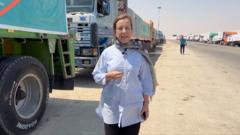Rafah Crossing: A Vital Lifeline Amidst Tensions
 The Tech Times
The Tech Times
In the heart of a region often marred by conflict and humanitarian crises, the Rafah crossing stands as a vital gateway between Egypt and the Gaza Strip. Recently, the world’s eyes have been drawn to this passageway as queues of aid trucks awaited entry into Gaza, highlighting the ongoing struggles faced by the Palestinian territories.
The BBC's Chief International Correspondent, Lyse Doucet, is currently on the ground, accompanied by Palestinian Prime Minister Mohammad Mustafa and Egypt’s Foreign Minister Badr Abdelatty. Their presence underscores the political significance and urgent humanitarian needs at the crossing.
Historical Context and Significance
Historically, the Rafah crossing has been more than just a border control point; it has been a symbol of hope and, at times, despair. Established as a pivotal crossing after the 1979 Egypt-Israel Peace Treaty, its operations are crucial for the Palestinian population. Unlike other border points with Israel, Rafah is the only crossing that does not fall under Israeli control, making it the primary exit and entry point for the residents of Gaza to the outside world.
The crossing has seen its fair share of closures and restrictions due to political tensions, security concerns, and regional conflicts. In recent years, the Egyptian government has intermittently closed the crossing, citing security threats from the Sinai Peninsula. Such closures have often left Gaza’s residents isolated, exacerbating the humanitarian challenges in the region.
The Current Situation
The current situation at Rafah reflects the broader geopolitical and humanitarian dynamics at play. With aid trucks lined up and waiting, there is a palpable sense of urgency. This scene is a stark reminder of the ongoing blockade imposed by Israel and Egypt on Gaza since 2007, following the Hamas takeover. The blockade was intended to limit Hamas's ability to import weapons but has also significantly impacted the civilian population, restricting essential goods, medical supplies, and the free movement of people.
International efforts, such as those seen with Doucet’s current mission, often aim to negotiate terms for opening the crossing to allow humanitarian aid to flow into Gaza. These negotiations are complex, involving multiple stakeholders with varying interests, including Hamas, the Palestinian Authority, Egypt, and Israel.
A Broader Perspective
The situation at Rafah is emblematic of a larger narrative of conflict, humanitarian need, and international diplomacy. It highlights the challenges faced by the international community in addressing the needs of the Palestinian people while balancing security concerns. The presence of high-level officials, such as the Palestinian Prime Minister and Egypt’s Foreign Minister, indicates a concerted diplomatic effort to address these issues.
This scenario also underscores the critical role of international media in bringing attention to regions often overshadowed by larger geopolitical narratives. Correspondents like Lyse Doucet play a crucial role in providing on-the-ground insights and humanizing the statistics and reports.
Conclusion: The Road Ahead
As the aid trucks wait at Rafah, the broader question remains: what future lies ahead for the people of Gaza? The crossing is more than a point of entry; it is a potential lifeline for a beleaguered population. Ensuring its regular and sustained operation could alleviate some of the humanitarian pressures faced by Gaza’s residents.
In the end, the situation at Rafah is a microcosm of the ongoing Israeli-Palestinian conflict, reflecting both the challenges and the opportunities for peace and cooperation. As the world watches, the hope is for a resolution that prioritizes the humanitarian needs of the Palestinian people, paving the way for a more stable and peaceful future in the region.
Source: BBC at Rafah crossing as queues of aid trucks wait to enter Gaza
Subscribe to my newsletter
Read articles from The Tech Times directly inside your inbox. Subscribe to the newsletter, and don't miss out.
Written by
